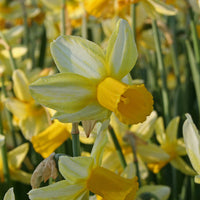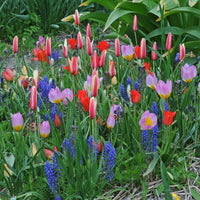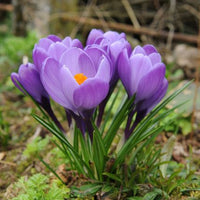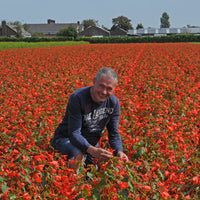Last winter I received a call from my Daffodil friend Brian Duncan asking if I would like to go with him to Spain to look for Daffodils in the wild.
Of course I was up for it, as long as it wasn't in April because that's when the daffodils bloom here. No, it was in February, to the south of Spain, Malaga, to drive up to Madrid in about ten days. And if I wanted to rent a car.
Brian always acts like he wants me to go, and he does, but another reason is that his wife won't let him drive a car himself. The good man is well into his 80s and his wife Betty will only let him go if he can get a more reliable driver.
But honestly, I love nothing more than going with Brian because I think there is no man in the world who can show you around Spain as well as Brian. He has been there more than 30 times and knows an awful lot about the wild Daffodils.
Many people always ask me what I saw there, hence this newsletter with all the beautiful things we found in beautiful Spain.

Narcissus bujei (synonym N. confusus)
This daffodil looks very much like a miniature version of the modern yellow Trumpet Daffodils. Apparently this is not true, the modern yellow Trumpet Daffodil is believed to be a descendant of the French Narcissus pseudonarcissuses.
We were just too early to see her in full glory, these were the first flowers found after a long search. She looks a lot like the Narcis pumilus we grew that I offer in the Fluwel web shop.

Narcissus bulbocodium
How beautiful it is, thousands and thousands of cheerful little hoop skirts in roadsides, on hills and all kinds of pieces of nature that are left alone. North of the town of Andujar, known for its olives, they can be found everywhere. Just like we have Dandelions along the side of the road, there they have the Bulbocodium Narcis.
The Mary Poppins that can be found in the Fluwel webshop is descended from this species.

Narcissus cantabricus
A sparkling white hoop skirt daffodil, the first cantabricus we came across we saw from the car at 50 kilometers per hour while it was almost dark. This daffodil is so incredibly white that you can almost see her in the dark.
Unfortunately, it is not so suitable for cultivation in the Netherlands, it blooms in the middle of winter, which causes it to freeze too often. You can find it in the far south of Spain and in some places on the northern coast of Morocco. It really loves the nice weather and the warmth. In the short term, you can expect very nice seedlings of this snow-white hoop skirt on the market that can withstand the Dutch weather a bit better.

Narcissus cerrolazae
This was a completely new name for me, I had never heard of it before; the Narcissus cerrolazae. As it turned out, a few years ago it was still called Narcis jonquilla var henriquesii.
We often say in the Netherlands 'Nothing is as changeable as the weather' but the gentlemen botanists can do something about it too. Especially when it comes to the yellow scented multi-flowered Narcissus of the jonquilla type that are common in Spain, the gentlemen don't seem to agree. I think the Narcissus doesn't care, it nestles somewhere in a rock crevice and is there to be wonderfully beautiful under the Spanish sun.

Narcissus fernandesii
Also about this Narcissus much bickering among the plant experts about what we should call her. Is it heniquesii, or fernandesii or maybe cordubiensis? Or is it perhaps a richly flowering form of cerrolazae?
It doesn't really matter to me, I think she is one of the most beautiful and best jonquilla types that can be found. At our nursery we have a large batch of them and we call her fernandesii . I expect that she will be found in many European gardens in the future because she is a problem-free Narcissus that can only do 2 things: grow fast and bloom richly.

Narcissus assoanus
Small but beautiful and seen in unimaginable numbers in large parts of the south of Spain. Narcissus assoanus is a reliable Narcissus that does well but just a bit too small to decorate the garden. I can imagine that she is a perfect Narcissus for the rock garden. Her descendants Desert Bells and Vireo are Narcissi that show themselves well in the garden.

Narcissus gaditanus
There are wild Narcissi in Spain that you really can't miss, in some places you can't walk without trampling them. That chance is not so great with the Narcissus gaditanus. To find her you really have to look for her.
She can be found on grassy rock formations and often stands there alone somewhere behind a tuft of grass where you don't expect her. But the nice thing is that you are really happy when you find one.

Narcissus incurvicervicus
Another miracle of Mother Nature. Narcissus incurvicervicus is not a true species but what is called a 'hybrid' (offspring) of two species. In this case it is the Narcissus triandrus and the Narcissus fernandesii . In the next photo you can see her where she is standing between her parents.

Narcissus incurvicervicus with its parents: on the left the white Narcissus triandrus and in the middle above the Narcissus fernandesii.

Narcissus litigiosus
Seeing the Narcissus litigiosus was a complete surprise. She is a very rare hybrid of the Narcissus cantabricus and the Narcissus triandrus. As a Daffodil breeder it is your biggest dream to find such beautiful Daffodils, Mother Nature shows here that She can do something about it too.

Narcissus tazetta pannizianus on a steep mountain slope. The small white dots on the green are the pannizianus, the larger white dots are bird droppings.

Narcissus tazetta pannizianus
Its flower looks a lot like the Narcissus papyraceus, but its behavior is very different. The payraceus is easy to find along fields and in roadsides, but to see this Narcissus up close you sometimes have to climb up rock walls at the risk of your own life. It is unbelievable that they can survive in such places.

Narcissus christopheri (syn koshinomurae)
Finding christopheri is special, she is rare. She is an illegitimate child from an affair between the Narcissus fernandesii and the Narcissus pannizianus. In addition, she is also on rock walls that are almost impossible to climb. But with much effort and hearing 'watch out' and 'don't do this' I managed to photograph her at a great height.

Narcissus tazetta papyraceus
The Narcissus papyraceus is known to many of us as the 'Paperwhite Narcissus' This was one of the most beautiful Narcissus we have seen in Spain. We were also lucky, it was in full bloom and stood like a beautiful weed in the field margins and along ditches blooming with its snow-white flowers. We have seen thousands of them.

Narcissus rupicola
To find rupicola you almost have to go to places where you absolutely do not expect to find anything beautiful. In places with very little green and only rock you have to climb to see it. But there it can suddenly appear from the smallest cracks. We were just a little too early to find many, it was still freezing cold up there on the mountains, but after a long search we did find a few in a sunny spot.

Narcissus triandrus subsp. pallidulus
What a delightfully modest Narcissus this is. The combination of her sad attitude, her beautiful shapes and her fresh colour make her one of the most beautiful Spanish Narcissus.
Narcissus triandrus is the mother of the legendary Narcissus Thalia . All other Narcissus cultivars from the Triandrus Narcissus group also originate from this Narcissus. But mother stays in Spain, she does not like the Dutch climate that much. But her children on the other hand travel all over the world.

Narcissus fosteri
Finally, a particularly beautiful Narcissus that originated from a cross between the Narcissus triandrus and the Narcissus bulbocodium. In places where these two species grow together, you can regularly encounter her. Because they all come from seed, they are all slightly different from each other. This tuft is truly unique, you rarely see her so beautiful.
Kind regards,
Carlos van der Veek













 Deutsch
Deutsch English
English
